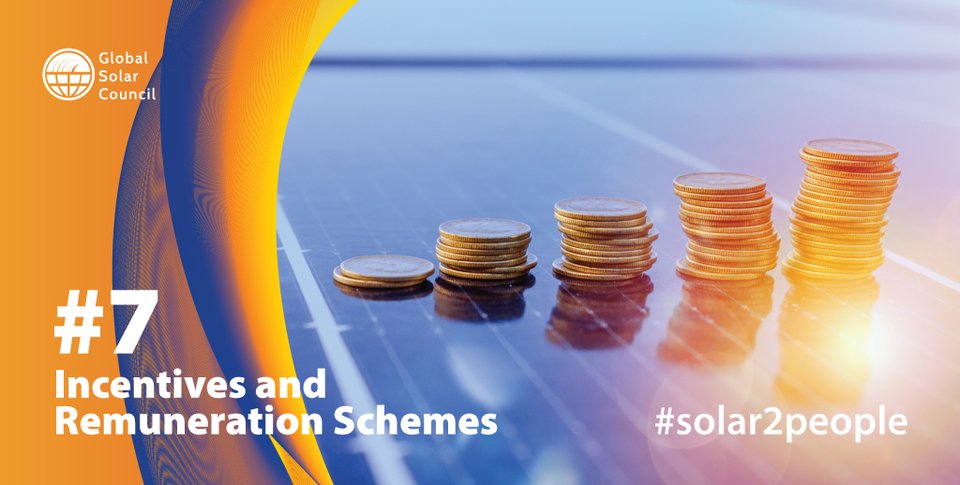Press Release, Solar 2 people
Incentives and high energy prices bring down solar PV investment’s payback time

Today, in most cases around the world, the development of solar PV plants does not require any sort of incentive. Indeed, the maturity of the solar market, with great reduction of installation costs over the past years, and the high prices of electricity in many countries across the globe are the main boosts to solar PV’s penetration. However, in particular circumstances and especially for small and medium size plants, the development of solar PV still requires some sort of incentives to reduce the payback time and accelerate the decarbonization of our society. This has prompted the creation of various incentive mechanisms over the years, which can benefit consumers worldwide. Although vast solar power’s potential still needs to be unlocked even in relatively mature markets, their experiences can be very useful for emerging markets to identify the best instruments for a solar deployment boost. Let’s take a closer look.
Incentives are a great tool to cut down installation costs for rooftop solar PV, while other mechanisms offer remuneration for the electricity produced and help shorten the payback time. Hence today, solar PV is ever more convenient as it allows to save on the high prices of the grid’s power and also to generate income.
Moreover, with innovative financing packages, tax credits and invoice discounts, the upfront costs are reduced, while solar power producers can start saving on electricity bills right away. Where incentives are not present, especially for small and medium size PV plants, citizens can influence policy makers to put them in place to speed up the energy transition: more generous where the market is emerging, of varied forms where the market is mature.
One of the most common mechanisms is the Feed-in Tariff, through which solar power producers receive a fixed price, for a guaranteed period of time (usually 15 or 20 years), for all the electricity generated (often the fixed price is higher for the energy injected in the grid and lower for the energy self-consumed). A very similar mechanism is the Feed-in Premium, through which solar power producers receive a fixed price for the energy produced and in addition can sell the electricity generated and not self-consumed instantaneously at a market price. Hence, the Feed-in tariff and Feed-in premium are incentives that offer remuneration for the energy produced, and this makes them very good instruments to stimulate growth in emerging markets.
Today, in many mature markets large scale solar PV plants do not need incentives anymore, but a Feed-in tariff mechanism (most commonly with a fixed price lower than the market price) combined with long-term contracts, guaranteed by the government, provides transparency, predictability and security, and therefore contributes to lowering investment risks and broadening access to finance. It also generally contributes to a more continuous and stable development of solar PV markets while providing an incentive to maximize the production of renewable electricity – thus to maintain solar PV systems correctly in order to ensure high performances – because Feed-in Tariffs are output-based.
For the above reasons, in many countries, Feed-in tariffs have proven their ability to stimulate rapid and large-scale solar PV market development as well as participation of small and medium scale solar power producers.
Another common and useful mechanism to foster private investment in solar PV, especially where the market is in its initial phase, is Net Metering. It is a regulatory instrument that allows to account for the electricity that is fed to the grid, using bi-directional meters that can measure the current flowing in two directions. Ultimately, power flows are balanced out and consumers pay only for the net electricity drawn from the network and consumed. In other words, they pay only for the power consumed in excess of the total electricity produced by the solar PV plant.
In this way, the grid itself acts as a battery, allowing solar power producers to use that power anytime, instead of only when it is generated. In other words, as an accounting procedure, Net Metering allows solar PV system owners to use the power generated during the day at night, or to use in December the power generated in July.
But this mechanism also burdens the network as it does not stimulate consumption on site or in the vicinity of production. As the market grows, the ideal system is one that includes residential energy storage and demand response systems, maximizing the consumption of power that is produced locally and reducing grid stress.
In mature markets such instruments are gradually replaced by others that account for these necessities and can thus work better while reducing costs for the system, like tax credits and higher incentives for self-consumption.
In fact, today self-consumption is the most important element. As we wrote in our second blog about the benefits for the grid: “It is important that rooftop solar plants are sized according to the demand they’ll need to satisfy, to minimize the excess energy to be fed to the grid and reduce investment cost in storage. In fact, in ideal systems the regulations would incentivize self-consumption more than feeding excess energy to the grid precisely to minimize grid stress. Also, since energy is produced on-site, there is less necessity to channel power along transmission lines, which eases the overall stress on the grid, reduce the need of transmission grid implementations and prevent energy grid losses thus producing significant savings.”
Commonly in mature solar PV markets, renewable electricity producers can consume the power they produce at no additional costs – and enjoying great savings in the current context of high energy prices – while they are remunerated at market prices for the excess electricity fed to the grid. The importance of self-consumption has prompted the creation of incentives for storage systems that are now generally included in tax credits, which reduce considerably the upfront costs, or in a premium for the power self-consumed.
From this point of view, energy communities represent a crucial evolution for our energy systems, as well as for our future, because they enable the sharing of photovoltaic systems within entire communities, which allows consuming even more energy produced directly on-site. Within energy communities, solar PV systems need to be sized according to the aggregated local consumption of the entire community, rather than to direct self-consumption of single households.
Regulations of energy communities are still under development worldwide, but the European Union has already set forth dedicated directives and some member states have implemented them with incentives that provide higher remuneration for the renewable electricity produced by energy communities and shared locally.
An additional instrument used in certain markets is the possibility to transfer the tax credit to the company that installed the rooftop PV system, which in turn discounts the invoice for the consumer, further reducing the burden of upfront costs. The role of banks is also important, as they can set up financing packages for solar PV that provide consumers a portion of the remuneration.
Take a look at this video in IRENA´s video series, on the steps to take when installing a solar system for more helpful information!
- An informative video from IRENA.
Our partner IRENA has released a set of informative videos on solar systems covering a wide variety of topics. This one (below) focuses on the advantages of opting for residential solar PV as a reliable electricity source, useful applications, and finally the financial, social, and environmental benefits.
![Global Solar Council [logo]](/static/images/gsc-logo-horizontal.svg)
